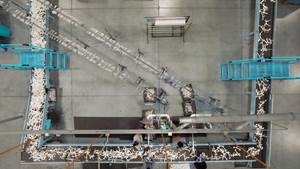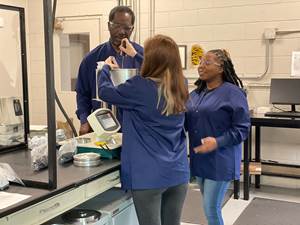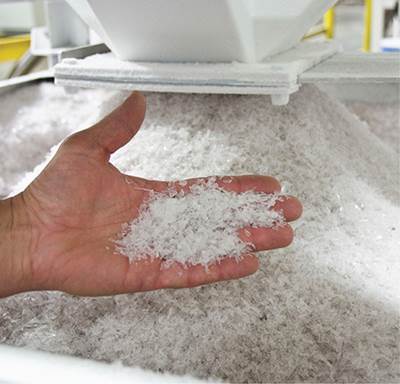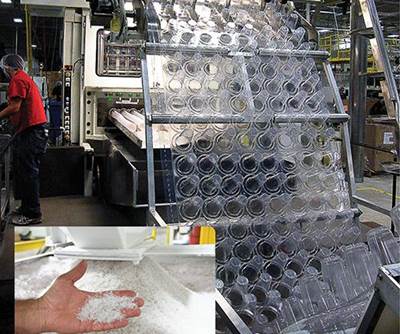How to Optimize Usage of Recycled Material
Processors need to “engineer” feeding properties similar to virgin pellets into their regrind to efficiently and economically utilize more of their scrap.
Almost every extrusion process generates some level of scrap that needs to be recycled for both economic and environmental purposes. But the amount of ground recycled material that can effectively be processed on the extruder and screw is usually limited because of differences between virgin pellets and regrind. During process upsets, trials and other processing interruptions, the amount of scrap generated is often far more than can be processed without sacrificing output rate and developing product variations due to output instability. Without separate extruders and/or screws designed specifically to process these greater volumes of ground scrap. you might wind up overcoming storage space and tying up a lot of money.
Most extrusion processes can effectively reprocess 10% to 20% reclaim with only minor changes in output and process stability. Some processors have even developed expertise in manipulating processing conditions, particularly temperature control, to accommodate somewhat higher levels of regrind. The main variables affecting these issues between virgin pellets and regrind are the bulk density and the solid particle flow properties. Keep in mind that the polymer manufacturers actively work to optimize their pellet geometry for optimum bulk density and solids-flow properties for their own benefit in material handling and packaging. As a result, most virgin pellets are well optimized for those properties.

Your granulating equipment controls the size and shape of regrind particles, which influence bulk density and feeding properties.
When virgin and regrind are introduced into the extruder, the differences in their bulk density and particle-flow properties typically cause a reduction in output related to the combined bulk density and a loss of output stability due to the varying particle-flow properties. In order to more closely equalize those properties for greater output and stability, more attention needs to be paid to the properties of the regrind.
More specifically, processors need to “engineer” feeding properties similar to virgin pellets into their ground recycle to efficiently and economically utilize more of their scrap. The two variables that have the most effect that they can control are the bulk density and the solids-flow properties of the regrind. The shape, uniformity and thickness of the scrap after granulating is seldom considered as a way to improve bulk density and solids-flow properties. In fact, relatively few of the people I have recently spoken to have ever investigated it.
In order to effectively process higher percentages of recycled material, regrind must approximate as closely as possible the bulk density and solid flow properties of the virgin polymer.
In order to effectively process higher percentages of recycled material, regrind must approximate as closely as possible the bulk density and solid flow properties of the virgin polymer. This will require greater control of the granulation process; not just feeding scrap into a grinder and dealing with whatever comes out as well as possible. Bulk density and solids-flow properties are easy to measure and are at least partially controllable for most extruded scrap, with the exception of thin films. Bulk density is simply the weight of a specific volume. The volume in the feed throat and feed section of the screw is fixed, so any reduction in bulk density is going to reduce the output.
Approximating the bulk density of the virgin not only maintains the weight of polymer going into the screw, but minimizes segregation of the virgin and recycle as the mixture flows from the hopper into the throat and then into the screw. The solids flow properties can be approximated by measuring the “angle of repose” and comparing it to that of virgin pellets.
The angle of repose may not seem an obvious indicator, but it is surprisingly representative of the particle-to-particle friction, which affects how the particles will compact in the feed section as well as flow into the screw. The particle friction is indicative of the strength of the solid mass or bed forming in the initial feed flights as the loose polymer particles compact. The faster and more effectively they compact, the more room there is for additional polymer and the greater the output of the screw. Bulk density and particle friction exert a great deal of influence over the feed rate for a given extruder/screw. In comparing the bulk density, the container used should be approximately a gallon to better average out inconsistencies in the particles exiting the grinder.
Although an extraordinarily simple test, angle of repose is a good indicator of how the granulated recycle will compare to the virgin pellets in the screw. Angle of repose is measured by slowly pouring the materials from a cup into a conical pile on a table and measuring the angle it makes with the table. The greater the angle the higher the pellet-to-pellet friction. The regrind will usually have a higher angle than the virgin pellets, but the goal is to approximate that of the virgin pellets so the differences minimize the effect on extruder performance. The same is true of the bulk density, where the density of regrind is almost always less than that of the virgin pellets.
In any regrind application, I always measure the comparative bulk density and angle of repose to get an idea of the difficulty of processing high levels of regrind.
In any regrind application, I always measure the comparative bulk density and angle of repose to get an idea of the difficulty of processing high levels of regrind. I do the same for any special screws designed to process up to 100% ground recycle, and then compare that with data I would use for a pellet screw design.
How can these properties of the ground recycle be improved? Most of the variables are in the mix of feed to the grinder, the grinder screens, rotor, cutter bars and blades. Mixing scrap from two different processes greatly complicates the adjustments for bulk density or solids-flow properties and should be avoided. The screens basically determine the size of the particles, while the blades and cutter bars tend to determine the shape. Newer grinder designs have some features that are adjustable such as bumper blocks, cutter- bar clearance or screen skewing. These allow for adjustment of particle size and shape without needing to tear down and replace parts. Maintenance of the grinder components is also important, as worn blades and cutter bars produce fines which are very detrimental to matching bulk density and solids flow.
Although optimization of regrind takes some time and money, once done you should be able to run much higher levels of regrind with minimal loss in output and process stability. Naturally, the knowledge of your grinder manufacturer will be invaluable in minimizing the iterations necessary to achieve significant improvements.
About the Author Jim Frankland is a mechanical engineer who has been involved in all types of extrusion processing for more than 40 years. He is now president of Frankland Plastics Consulting, LLC. Contact jim.frankland@comcast.net or (724) 651-9196.
Related Content
Avoid Four Common Traps In Granulation
Today, more than ever, granulation is an important step in the total production process. Our expert explains a few of the many common traps to avoid when thinking about granulators
Read MoreFoam-Core Multilayer Blow Molding: How It’s Done
Learn here how to take advantage of new lightweighting and recycle utilization opportunities in consumer packaging, thanks to a collaboration of leaders in microcellular foaming and multilayer head design.
Read MoreReversing Logistics for Plastic Film Recycling
Learn how Mainetti built a circular supply chain for clear film packaging.
Read MoreSD Polymers: 'One-Stop Solution for Mechanical Recycling'
‘Passionate’ recycler invests in people and technology to meet commitment to innovative, sustainable solutions for its processor customers.
Read MoreRead Next
Regrind and Melt Pumps
Changing levels of regrind can result in unstable output. If not set up properly, a melt pump can add to this instability—the opposite of the intended effect.
Read MoreEXTRUSION: Managing Regrind
Reusing scrap is a necessary evil. But be aware of the negative impact scrap has on properties and extrusion efficiencies. Start by developing a regrind-usage program.
Read MoreHow Much Regrind Can You Handle?
Most extrusion operations generate scrap, and in the case of sheet for thermoforming it can exceed 70% of total output.
Read More
.jpg;width=70;height=70;mode=crop)
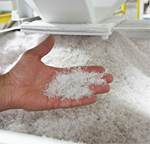

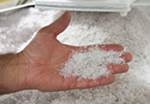













.png;maxWidth=300;quality=90)







